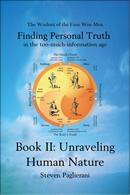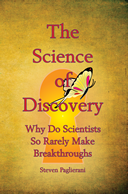Mistaking Symptoms for Wounds
Most therapies assume that when we suffer, something is broken—and that if we eradicate our symptoms, then the source of this suffering is gone. Surprisingly, even highly effective, esoteric talk therapies like EMDR and NLP assume these things. The problem is, symptoms are not the wound. Thus anything which eliminates symptoms more times than not just hides the wound. Indeed, if a word exists for something, then this something occurs a lot. The word which points to this idea being true is the word, "asymptomatic." Current therapies cannot differentiate between being healed and being asymptomatic. And in truth, more times than not, when a therapy claims healing, it's the latter.
These articles explore ways that talk therapy could address this problem. Know that many predate my discovery of the Map of the Mind in June 2008. This means, the language used in them varies a bit from what I use today—and from what I use in my books. Conceptually though, nothing has changed from my first discoveries in 1996—that painful surprises are what cause wounds, and that pleasant surprises are what heal them. Moreover understanding the nature of wounds and how to heal them is still the heart and soul of any talk therapy.
The most significant events in all of human experience are those that surprise us. Oddly, few of us ever make surprise an area of study. Rather, most of us spend our days trying to avoid pain. Ironically, the key to avoiding pain lies in learning about the two surprises.
The Significance of Blankness (the Missing Piece in Therapist's Conversations)
This series originally ran in 2007. Thus some of the wording used here changed after I discovered the Map of the Mind in June 2008. This said, the concepts written about here remain relevant. And useful. Surprisingly, few therapists ever teach their clients these things let alone anything regarding the therapeutic process. Thus few clients ever participate as equal partners with their therapists in the healing process.
I myself find this sad. No therapist should ever sit in judgment above another human being. Nor should any client put their therapist on a pedestal. Hopefully what you read here will help you to be more on equal ground with your therapist. And yes, therapists have special skills that clients need not learn. But clients who understand what is happening to them in therapy have a better chance to heal.
Why Talk Plainly? (do words really matter that much?)
What Makes People Go to Therapy? (what does the word "psychotherapy" mean?)
What Are My Issues? (moving from words to healing)
What Makes a "Good Therapist" Good? (the seven personal criteria)
What Will We Talk About? (the twelve emergence block markers)
Are We Ever Done With Therapy? (healing as Zeno's Paradox)
Why Does the Good in Therapy Not Always Last? (introducing the Ten Nested Layers of Personality)
What Causes Addiction? (things which alter our perception of time)
Why Do We Get High? (how the body-mind time differences cause euphoria)
Making Breakthroughs (how is your therapy going?)
What Do All Good Therapies Have In Common? (the fractal for a good therapy)
Should Therapists Teach People to Blame? (the blame canceling fractal)
Therapy and the Mind Body Connection (the most important concept in talk therapy)
The Voices of the Mind Body Connection (Thoughts and Impressions)
The Philosophy of Talk Therapy (resolving the Cartesian Split)
The Physics of the Mind Body Connection (finding the master clock)
Mind Body Connections (how they happen)
Hollowness in Relationships (show-first, tell-first cycles)
The Therapist's Role in Addiction and Recovery (how your Mind Body preference makes you vulnerable to addiction)
Managing Overeating with a Mind Body Speedometer (creating a psychophysical time-perception monitor)
ADD and Learning (a mystery solved)
Thoughts, Feelings, and Talking in Therapy (how sensation creates the content of the mind)
What the Eyes Tell in Therapy (Emergence Personality Theory and the mind body connection)
Endings in /therapy (an epilogue of sorts)
Most of what you'll find in this section centers on Emergence Therapy, an approach to healing which focuses on things which cause your mind to suddenly go blank. Know it's these moments of sudden blankness which underlie all failed efforts to change. You can't change what you can't see. This sudden blankness also prevents you from visually recognizing your needs—and if you fail to see a need for long enough, this will result in symptoms. In effect, you can't meet a need which you can't visually recognize. Emergence Therapy is a systematic approach to finding—and healing—blanknesses in the mind. And as you heal, you realize—and meet—more of your needs.
Emergence-Based Therapy vs. Traditional Therapy (what makes emergence therapy different?)
Emergence-Based Therapy vs. Traditional Therapy (a quik list)
Emergence as a Therapy (a brief look for therapists and those wishing to heal)
The Five Kinds of Scenes Which Emerge in Healing Moments (Specific, Composite, Blended, Imaginary, Here and Now)
The Three Healing Modalities of Emergence Therapy (P-Curves, Visual Dialogue, Direct Emergence)
Using the Three Modalities to Focus Healing Efforts (thoughts on when to to use each modality)
Emergence: Theories to Therapy (how the theories became a therapy)
What Makes Therapy Take So Long? (how focusing on symptoms prevents healing)
On the Value in Empirically Defining Wounds (more on why therapy takes so long)
Does Getting Rid of Painful Feelings Heal Anything? (a talk with someone who believes this)
To Rita: On What Qualifies Me to be a Therapist (a bio of sorts for anyone interested)
Helping Folks with Depression (a few thoughts on where to begin)
I've been a talk therapist for something like twenty-five years. During this time, I've frequently advocated for non blaming descriptions of people's struggles. This said, we live in a world where insurance companies only pay benefits based on medical terms. And medical terms are by their nature, both inadequate and blaming. So can we ever learn to see past the idea that we are our problems. I believe we can. But only if we can build a bridge between the medical and non medical worlds. These articles look to build that bridge.
What Makes Mental Illness So Hard to Heal? (a more loving perspective)
Why Aren't We All Mentally Ill? (wounds vs character disorders)
Redefining Mental Illness and Health (the 3 perspectives: psycho-functional, psycho-medical, psycho-visual)
How Visual Intensity Maps Explain Mood Disorders (mania to depression)
What is Paranoia (a young student asks)?
Help My Mind is Racing (advice to sufferers of anxiety attacks)
In each of these stories, someone experiences a pleasant surprise, after which this person's life is permanently changed for the better. What is especially important to see here is how no logic-of-the-psyche is used to heal these wounds. The healing came entirely from addressing the blankness in people's minds.
"No Lefts" ~ the Never-Ending Marital Fight (the woman who couldn't remember directions)
The Grumpy Wife's Alarm Clock (wounded by watching a movie)
Afraid of Needles ~ Healing a Phobia (the girl who learned to love blood tests)
Jacob's Story (the baby who hated mustaches)
The Husband Who Hated Vacuums (healing sounds you hate)
The Fear of Flying (an emergence therapist's story)
Getting Over the Fear of Flying (some suggestions for Michelle)
He Almost Killed His Mother (wounded by words before he could speak)
Dr. K's Story (wounded by prejudice)
Once you understand the connection between wounds and being startled, you realize the things that wound us cannot be rooted in logic. If they were, we could use logic to avoid being startled. We can't. Startles are unpredictable.
The problem is, most therapies don't know about how wounds connect to startles. So they base their methods on why-logic and logic-of-the-psyche. But as Rumi says, "the eye goes blind when it only want to see why." Ergo the error in most modern therapies.
Flaw 1: Mistaking the Absence of Symptoms for Healing (the most common error therapists make)
Flaw 2: Assuming the Wrong Sequence (Event > Interpretation > Response)
Flaw 3: Mistaking Damage Control for Healing (better logic does not heal)
Flaw 4: Overlooking the Importance of Ahas (not knowing what healing actually is)


.png)

